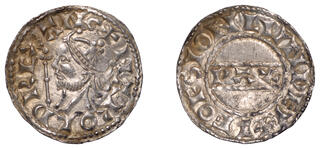| Noonans (formerly Dix Noonan Webb) > Auction 290 | Auction date: 21 February 2024 |
| Lot number: 1069 Price realized: 6,000 GBP (Approx. 7,567 USD / 7,003 EUR) Note: Prices do not include buyer's fees. | Show similar lots on CoinArchives Find similar lots in upcoming auctions on |
| Lot description: Harold II Harold II (1066), PAX type with Sceptre [BMC I; N 836; S 1186], Penny, London, Leofsige, Gp D var., +harold rex ang, crown with curved band, rev. +leofsi on lvndei, 1.33g/3h (Bt 76, this coin; Pagan, NM p.192 [20+ specimens noted]; BMC 67). About extremely fine, gently bowed emphasising the superb portrait, light hoard patina over fresh metal £3,400-£4,000 --- Struck from the same obverse die as Braintree 77 Within the short reign of Harold we find a degree of compositional variation. The most fundamental distinction can be drawn between those coins which feature a sceptre by the bust and those which do not. In his authoritative essay on the coinage of Harold II, Hugh Pagan recognised four distinctive styles of obverse die (determined by factors such as the form of the crown and placement of the legend). Groups A and B feature straight crowns and include the sceptre; groups C and D employ curved crowns and are most often without sceptre. The lack the royal sceptre on some of Harold's pennies has been discussed recently by Gareth Williams who concludes that 'There is no reason to read any particular significance in the absence of the sceptre, and it seems likely that the omission was simply the result of carelessness'. Several points can be offered against Williams' proposal, not least the fact that the majority of coins belonging to groups C and D are well-formed and attractive, showing no sign of carelessness. Pagan noted that the group D coins in particular have an 'experimental' character and it seems preferable to view this portion of the coinage as coming at the start of Harold's reign. Coins of group D carry a quite distinct portrait; the king with heavy brow and the beard depicted by a series of short parallel lines. The responsible engraver (or an apprentice) continued to cut dies for group B (Bt 45, 55). It seems reasonable to assume that the rare group D variants (Bt 76, 77, 116) with the added sceptre represent a transitional period. Braintree 77 was struck from a reverse die later used, in a more worn state, to strike Braintree 74, a group A penny and this resonates with the stylistic primacy of group D and its variants. One possibility is that the addition of a sceptre was made in order to stress the legality of Harold's succession which was not universally accepted and to emphasise the regality of his position and person. If so, the present coin offers fascinating insight into how royal power was projected and received on the eve of the Norman conquest. |  |


